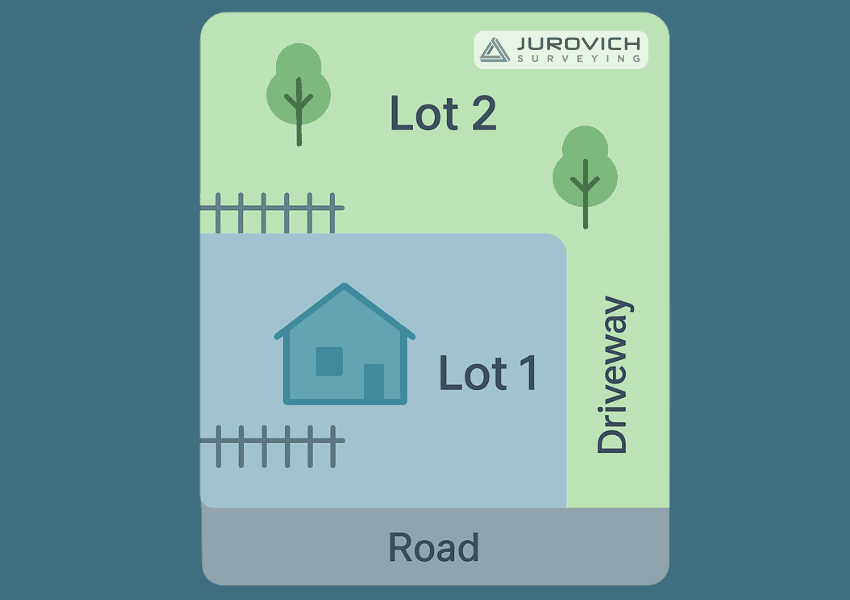
Battle Axe Subdivision
Some good insights into this popular type of subdivision so that you can make an informed decision on whether it’s right for your home.
What is a Battle Axe Subdivision?
Perth’s urban landscape has been changing over the years with a distinct subdivision style known as battle axe subdivision. It allows for the creation of a new dwelling at the rear of an existing, potentially character-filled, front house.
The new rear lot is accessed from the street by a long narrow driveway, which is where the name battle axe comes from. When viewed from above, or on a plan, the driveway looks like an axe handle and the rear block looks like the axe blade.

This type of subdivision has become a common solution for unlocking the development potential of larger, established residential blocks.
For landowners in Perth looking to subdivide, understanding the intricacies of the battle axe configuration – its benefits, challenges, and the subdivision process itself – is crucial. At Jurovich Surveying, we have extensive experience in guiding clients through these subdivisions, and here we aim to shed light on this popular, yet sometimes complex, property arrangement. Get a fast subdivision quote.
Benefits
Unlocking Land Value
The primary driver behind creating a battle axe block is to unlock the value of a larger, single residential lot. By positioning a new dwelling at the rear and retaining (or building anew) on the original street frontage, landowners can effectively create two separate titles.
By doing this, the value of the two blocks becomes greater than the original larger block due to market demand. It also creates the potential for an additional income stream through building an investment property, or the option to sell one block for a profit.
This approach is particularly appealing in established suburbs, where large blocks are increasingly sought after but rarely available as undeveloped land.
Multi-Generational Living
Beyond the financial advantages, the battle axe subdivision model has become an increasingly popular choice for accommodating multi-generational living. With rising house prices and an ageing population, many families are looking for ways to live closer while maintaining privacy and independence.
A battle axe subdivision allows for a parent or grown-up child to build their own home on the rear lot, while the family remains close by on the front lot. This arrangement facilitates shared caregiving responsibilities, provides a built-in support network, and can strengthen family bonds.
It offers the best of both worlds: the security and community of having family nearby, combined with the personal space and separate title of a stand-alone home. It’s a practical and sustainable way for families to stay connected in an evolving housing landscape.
Privacy
One of the key advantages is the enhanced privacy enjoyed by the rear dwelling. Shielded from the street by the front property, residents of the battle axe block often experience a quieter and more secluded environment. Furthermore, the rear lot can sometimes offer a decent space for a garden or outdoor living area, depending on the original block size and zoning regulations.
Challenges
Despite these benefits, there are several challenges to consider.
If the Driveway is Shared
Depending on the width of the original block and orientation of the existing home, the driveway may be shared. If so, this can lead to potential conflicts regarding access, maintenance responsibilities, and even parking. Clear legal agreements, often in the form of easements, are essential to define these aspects and prevent future disputes.
Length of Driveway
The length of the driveway can also be a practical concern, potentially increasing the cost of construction for services like water, power, and sewerage to the rear property. Moreover, emergency service access and visibility from the street can sometimes be factors that require careful planning and adherence to specific regulations.
Process of Battle Axe Subdivision
The process of creating a battle axe subdivision in Perth involves several key stages, where the expertise of a licensed surveyor like Jurovich Surveying becomes invaluable.
1. Initial Assessment and Feasibility Study: Before embarking on the subdivision, a thorough assessment of the property is crucial. This involves considering the zoning regulations (including the Residential Design Codes or R-Codes), the size and dimensions of the land, existing infrastructure, and any potential constraints such as easements or restrictive covenants. A surveyor will conduct a preliminary site survey and provide advice on the feasibility of a battle axe subdivision.
2. Planning Application: Once feasibility is established, a detailed planning application is lodged with the local council. This application will include plans outlining the proposed subdivision, the location of the new lot and driveway, and how it complies with all relevant planning regulations, including setbacks, site coverage, and parking requirements. The council will assess the application and may request modifications or further information.
3. Western Australian Planning Commission (WAPC) Approval: If the local council supports the application, it is then referred to the WAPC for final approval. The WAPC considers the broader strategic planning context and ensures the subdivision aligns with state planning policies.
4. Survey and Pegging: Upon receiving WAPC approval, a licensed surveyor will undertake a detailed survey of the land, accurately marking the new boundaries of the battle axe block and the shared driveway. This involves placing permanent survey marks (“pegs”) to define the legal boundaries.
5. Civil Works: Depending on the requirements of the approval, civil works may be necessary. This can include constructing the driveway to council specifications, connecting services (water, sewer, power, gas) to the new lot, and addressing any drainage or stormwater management requirements.
6. Lodgement of Diagram or Plan of Survey: The surveyor will prepare a detailed Diagram or Plan of Survey, which legally defines the new boundaries and any easements (such as the right of way for the driveway). This plan is lodged with Landgate, the state’s land information authority.
7. Creation of New Titles: Once Landgate has approved the Diagram or Plan of Survey, new Certificates of Title are issued for the newly created lots, officially completing the subdivision process.
Back to FAQBack to FAQ